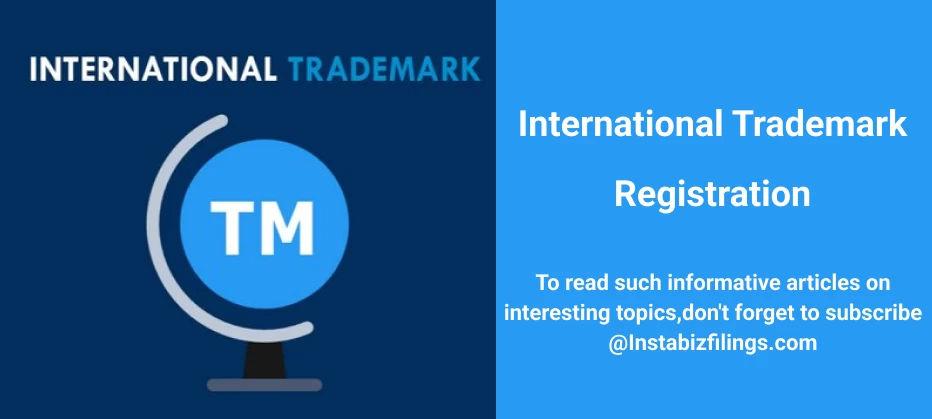
International Trademark Registration
September 22, 2025 by Team Instabizfilings
Introduction
The contemporary globalised economy has seen business being conducted beyond the boundaries of countries. It is important to safeguard a brand in a foreign country to ensure the identity of a company, its reputation, and market presence. It is in this regard that International Trademark Registration becomes very crucial.
An international trademark enables an organisation to safeguard its brand names, logos or slogans in numerous countries when a single application is made and thus simplifies the process of protecting brand names, saves on time and money.
What is a Trademark?
A trademark is a clearly identifiable sign, structure, word, phrase or symbol that denotes and differentiates the origin of services or merchandise of one party as compared to those of another. It is a useful intellectual property to companies.
What is International Trademark Registration?
The concept of protecting a trademark in several countries under a single system is referred to as International Trademark Registration, which is mostly referred to as the Madrid System under the umbrella of the World Intellectual Property Organisation (WIPO).
Businesses may use WIPO to create a single application which is then designated to countries of choice instead of registering the trademark for each country separately.
Key Systems for International Trademark Registration
- The Madrid System (Madrid Agreement and Madrid Protocol)
-
Granted by: World Intellectual Property Organisation (WIPO)
-
Established: 1891 (Madrid Agreement); 1989 (Madrid Protocol)
-
Countries: more than 130 member countries (the USA, UK, EU, China, Japan, Australia, etc.)
- Benefits of the Madrid System:
-
File a single application in one language.
-
Make payments in a single currency (Swiss Francs - CHF).
-
Control your trademarks (renewals, change of ownership among others) beyond a single system.
-
It is both cost effective and time saving as opposed to application in individual countries.
Eligibility for International Trademark Registration
To apply through the Madrid System, an applicant must:
-
Be a simple application or registration in their home country (so-called Office of Origin).
-
Be a national, resident or possess a real and effective industrial or commercial establishment in a member country to the Madrid Protocol.
Step-by-Step Process of International Trademark Registration
- Step 1: File a National Application or Obtain a National Registration
- You must first apply for (or already hold) a trademark in your home country’s trademark office. This is known as the basic mark.
- Step 2: File an International Application through the National IP Office
- After a basic application is established, a national IP office (including the USPTO in the USA or the IP India office in India) submits a copy to WIPO, who in turn applies the WIPO.
- Step 3: WIPO Examination
WIPO examines the application for formalities:
-
Ensures all information is correct.
-
Collects and confirms fees.
-
Assigns an International Registration Number.
-
Publishes it in the WIPO Gazette of International Marks.
- Step 4: National Examination by Designated Countries
Each country (also called a designated contracting party) then examines the trademark as per its national laws. Each country can:
-
Accept the trademark.
-
Object to it (called a provisional refusal).
-
Ask for additional information or clarification.
- Step 5: Protection is Granted
- In the event there is no refusal in 12 to 18 months (depending on the country) your trademark is automatically safeguarded in that country as though it were directly registered there.
Documents Required
-
Copy of the basic application or registration.
-
Details of the applicant (name, address, nationality).
-
Representation of the trademark (image/logo).
-
List of goods/services classified under the Nice Classification.
-
List of designated countries.
-
Power of attorney (if filed through an agent).
-
Applicable fees.
Fees Involved
Fees are calculated based on:
-
A basic fee (approx. CHF 653 for a black-and-white mark; CHF 903 for color).
-
Further charges on each specific country.
-
The fees differ depending on the country (they apply fees per case, rather than regular fees).
Validity and Renewal
-
The international registration is valid for 10 years from the date of registration.
-
It can be renewed every 10 years by paying the renewal fee to WIPO.
-
Changes (like name, address, ownership transfer, etc.) can be recorded centrally via WIPO.
Advantages of International Trademark Registration
-
Simplified Process: One application for multiple countries.
-
Cost-Effective: Saves on legal and administrative costs.
-
Centralized Management: Renewals, changes and expands are done centrally.
-
Global Brand Protection: Stops international brand abuse or infringement.
-
Flexibility: The additional countries may be added as the business grows.
Limitations and Considerations
-
Not every country is a member of the Madrid System (e.g., some of the nations in the Middle East and Africa).
-
In case the basic application/ registration is revoked within 5 years of time, international registration too is revoked (known as central attack).
-
Every given country possesses the right to deny protection on its own laws.
-
Objections can be required to have further legal and translation backup.
Alternatives to the Madrid System
You should not be a member of the Madrid Protocol by a country and instead, you should:
-
Register a national trademark directly in that country by a local trademark attorney.
-
Abide by law procedures and schedules of that country.
Common Challenges
-
Temporary rejections by nations because of similarity with already existing marks.
-
Language issues or process dissimilarities.
-
Checking the possible violations in the foreign countries.
To prevent such, it can be useful to seek advice from IP law firms or trademark agents focusing on international registration.
Conclusion
The International Trademark Registration is a potent device to those businesses that just want to go international and secure their brand name overseas. Companies are able to achieve international protection with less complexity, time and cost with the assistance of the Madrid System. Nevertheless, it is necessary to be guided properly through the system with the help of legal advice and strategic planning to avoid the pitfalls.
In both startups and expanding companies, multinational corporations, etc., international trademarks are an indispensable part of the process of increasing and protecting a worldwide brand image.
Disclaimer
The information provided in this blog is purely for general informational purposes only. While every effort has been made to ensure the accuracy, reliability and completeness of the content presented, we make no representations or warranties of any kind, express or implied, for the same.
We expressly disclaim any and all liability for any loss, damage or injury arising from or in connection with the use of or reliance on this information. This includes, but is not limited to, any direct, indirect, incidental, consequential or punitive damage.
Further, we reserve the right to make changes to the content at any time without prior notice. For specific advice tailored to your situation, we request you to get in touch with us.


